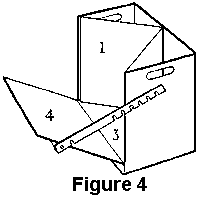The Reflective Open Box Solar Cooker
Roger Bernard offers a new compact reflective cooker design

Let us not forget that the SPC was designed as a substitute for the traditional box for small quantities of food. The dimensions given for my prototype in SBJ #16 are appropriate only when cooking for one person.
During the 1994 summer, I somewhat improved the SPC's convenience and efficiency by introducing two changes: a new system for creating the greenhouse effect and a more compact design.
Undoubtedly, oven bags are unbeatable for their lightness, but in my city (Lyon, 500,000 inhabitants) there are no oven bags available in the supermarkets. On the other hand, Pyrex salad bowls are very easy to find everywhere in France--even in small towns. Their price (about $4 US) is ten times the price on an oven bag, but they can be used hundreds of times for solar cooking as well as for other purposes in the kitchen. For traveling, however, they are relatively heavy and cumbersome.

This can be done by placing the dark pot into a glass dish whose diameter is slightly larger than that of the pot.
Obviously the advantages of such a system are partially offset by extra heat loss from the uninsulated lid. By raising the pot off the ground a further gain is achieved. In fact, my experiments have shown that cooking times with this new system are no longer than with the original design with a salad bowl up-turned over the pot.
In order to improve stability, I reduced the number of panels from five to four. A pleasant surprise was that the removal of the central back panel not only resulted in a more compact and stable cooker, but also improved the efficiency of the reflective surfaces, by permitting multiple reflections between the two remaining vertical panels. This peculiar assembly I propose to call a "reflective open box" (ROB) to distinguish it from the original solar panel cooker (SPC).
Construction



 A wooden prop can be used to adjust the front panel (figure 4). The single notch near panel 4 is used to lock this panel in a closed position for storage. Rocks can be placed in the triangular chambers behind panels 1 and 2 to stabilize the cooker in the wind.
A wooden prop can be used to adjust the front panel (figure 4). The single notch near panel 4 is used to lock this panel in a closed position for storage. Rocks can be placed in the triangular chambers behind panels 1 and 2 to stabilize the cooker in the wind.
In summary, the ROB seems to be a more convenient and efficient design that could replace the original SPC for regular home cooking. Of course, the latter equipped with an oven bag remains a better design if a light-weight, foldable cooker is needed.
Roger Bernard can be contacted at
A.L.E.D.E.S.
Université de Lyon
69 622 - Villeurbanne
France
 There
are also
plans for making this cooker in a way that it is collapsible.
There
are also
plans for making this cooker in a way that it is collapsible.